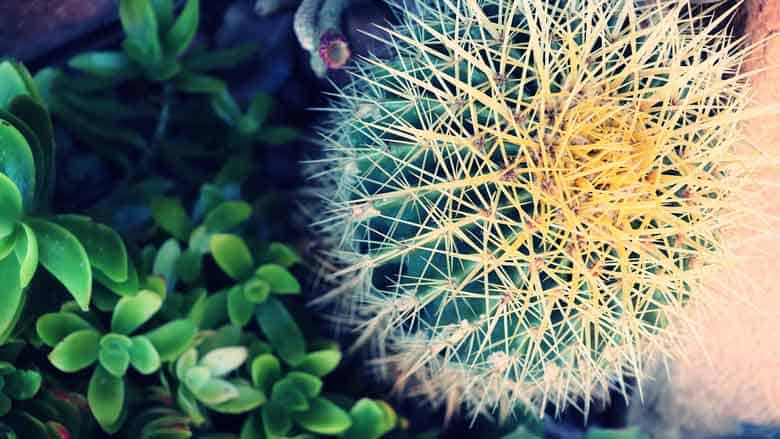Cactus plants are some of the most beautiful and diverse species that can be grown outdoors.
Cacti come in many shapes, sizes, colors, and textures. They also require very little water or care to grow outside.
The following article will provide you with everything you need to know about growing cactus plants outdoors in your garden or landscape.
How Do You Start a Cactus Garden
Outdoor Cactus Gardens are not all that difficult to start.
However, you will need to take care in deciding on the location for your cactus garden since they require a good deal of sun and can be sensitive to frosty weather conditions.
Where To Place Cactus Outside the House
Outdoor cactus gardens are typically placed either in a sunny location free from cold drafts or in a site with partial shade.
If you live in an area where it can get cold, make sure that when choosing your cactus planting location, you select one that will not expose them to freezing temperatures and be aware of wind drafts that may damage or kill your plants.
Cactus plants can be planted in just about any sunny location in areas that do not get very cold or windy.
When planting your cactus garden outdoors, make sure you give them plenty of space to grow as they will eventually become larger than what many people are accustomed to seeing and then need a lot more room.
You should plan on spacing them ten feet apart if possible for the best results with their growth.
You can also group two or three together at various intervals throughout the landscape, depending on how much sun is available and where you plan to plant your garden outside.
When growing cacti outdoors, one of the advantages is that they can be grown both in containers and on the ground.
How to Plant a Cactus Container Garden
Cactus plants are very versatile and can be planted in containers with a wide variety of sizes, shapes, and colors.
If growing in pots, it is essential to select one with a drainage hole in the bottom.
This will allow excess water and fertilizer to drain out so they don’t become too heavy or wet for your plants which can cause them injury which may kill them.
The best containers for cacti are terracotta pots.
These pots allow for good air circulation and are porous, which will not suffocate your plants due to the lack of oxygen if they become wet.
Additionally, terracotta pots also allow for better drainage so that excess water doesn’t accumulate in them and can hold more soil than some other types of containers do.
Cactus plants can be grown in containers that are full of small stones or rocks.
This will allow for better drainage and air circulation, but they must not have any holes where water may accumulate, which would cause them to become wetter with less oxygen.
If you live in a region where the soil is moist, it’s best to plant your cactus container garden on top of gravel instead so that excess moisture doesn’t seep into their roots.
To minimize exposure to frost, place tall pots near walls or fences out of direct wind when planting your cacti outdoors during the late fall and winter months.
If this isn’t possible, wrapping the pot with bubble wrap insulation will help keep them from being damaged by the cold.
How Do You Plant a Cactus in the Ground?
If you are planting a cactus in the ground, it’s important to choose an area with well-drained soil.
This will help keep water from accumulating and creating a wet environment which can lead to root rot or other damage to your plants.
It is best for their tender roots not to come into contact with grass because this may cause injury as they grow outward toward the sun providing them nutrients through photosynthesis.
It’s also important to keep in mind that cacti can grow very tall, so they should be planted at least four feet away from any obstacles such as fences or structures.
Once you’ve found the perfect spot, dig a hole about two inches deep and set your plant inside. Fill with soil around it until level with the surface of the ground and pat down firmly.
You can also put a thin layer of gravel or sand at the bottom to help with drainage.
After planting, water your cactus thoroughly and keep an eye on it for a few days if any problems are developing that show themselves right away.
When Should I Plant Your Cactus Outside
Cactus plants are best planted outdoors in the late spring to early summer while they are actively growing.
Picking the perfect time to plant your cactus outdoors is important, as you do not want it to be planted outside too early and potentially freeze or have its growth stunted.
Frost can damage the roots of a cactus so wait until after frost has stopped before planting it.
How To Take Care of a Cactus Outdoors
Although cactus care is relatively easy, some things should be done to ensure they grow and stay healthy.
Here are the basic guidelines for cacti care in the garden.
Sun Exposure & Light Requirements
Cacti need full sun exposure and don’t like low light conditions.
If possible, place the cactus in a spot that gets an average of six hours of sunlight per day to ensure it thrives as well as possible.
To make sure the cactus gets adequate light, it’s a good idea to keep them in pots that are at least 18 inches deep.
This will allow for better root growth, and they can be raised off of the ground, so they get more sun exposure.
If there is not an area where full sunlight may reach your plants, consider buying grow lights or installing artificial lighting on poles near their location.
These little efforts should go a long way towards giving your succulent plant enough light each day to thrive!
Watering Requirements
Cacti are drought-tolerant plants, but they do require some water. They need to be watered once every week or two, approximately if needed.
Too much water can damage the roots and rot them, so it is crucial not to overwater.
If the water becomes scarce in a drought situation, do not worry! Cacti plants can go for weeks without any rain or watering at all.
It is a good rule to only water cacti plants if the top of the soil is dry.
The best time for watering a cactus plant is in the morning, before noon. This allows the water to dry before evening, which can cause fungus or other problems.
Requirements for Growing Cactus
The best soil for cacti is a well-draining soil. This is because cacti are very sensitive to overwatering and rot.
Sandy soils that drain quickly will work best for most types of cactus.
The soil should be sandy, and the pot should have a drainage hole to make sure water can drain from it.
If you utilize a commercial mix for cacti, you will want to find one with high sand content.
You don’t want anything too dense or heavy because this will not allow enough space for air between the particles of dirt, which will suffocate your plants over time.
A cactus soil mix is the perfect blend of sand, perlite, and peat moss.
There are also various cacti-specific potting soils on the market that have been specifically formulated for these desert plants.
Temperature and Humidity Requirements
Cactus plants are native to arid environments, so they do not require very high levels of humidity.
They can be grown outdoors with a minimum temperature between 40 and 50 degrees Fahrenheit (or about five degrees Celsius) as long as there is plenty of sun exposure.
The ideal temperature range for cactus plants is around 65-90°F (18-32°C).
Fertilizing Requirements
Cactus plants are different from other plants because they don’t need to be fertilized too often. This is because they are succulent plants and trap moisture in their leaves.
They need to be fertilized only once every few months, or even less often than that.
The best type of fertilizer for cactus plants is a water-soluble fertilizer, which can be mixed right in with the potting mix.
Common Problems
The most common problems with outdoor cactus plants are overwatering and underwatering.
Overwatering can cause root rot because the roots are in a wet environment for too long.
Underwatering is just as bad, if not worse, than overwatering. This results in sunburned leaves and causes them to wither from lack of water and nutrients.
To prevent over or underwatering, always water cactus plants when the potting mix starts to dry.
Another way to ensure that there is enough moisture for the roots without overwatering them is by adding mulch around the base of the plant.
This will help retain some moisture while still allowing airflow to reach down into the soil where most of its nutrients are located.
5 Popular Types of Cactus To Grow Outdoors
Bunny Ears Cactus (Opuntia microdasys)
With its soft and fuzzy appearance, Bunny Ears Cactus is one of the most popular types of cactus to grow outdoors.
The plant does not require much maintenance through watering or fertilizing.
It stores water in a thickened stem with an extra layer for protection from heat.
This also serves as insulation against the winter cold.
Easter Cactus (Rhipsalidopsis gaertneri)

Easter Cactus is a small, compact, and highly colorful cactus. It has very stiff leaves that range in color from green to blue-green and purple.
The flowers are purplish-pink or lavender with long whiskers on the outer petals; they bloom all year round.
Golden Barrel Cactus (Echinocactus grusonii)

The Golden Barrel Cactus is a large, globular-shaped cactus with golden spines and can grow up to three feet in diameter.
The flowers are usually yellow with deep purple markings on the outer petals; they bloom mainly during late winter through early spring.
Hedgehog Cactus (Echinocereus engelmannii)

The Hedgehog Cactus is an extremely low-growing and spreading cactus with long, dark green spines that resemble oversized bristles.
The flowers are small but appear in clusters all year round; they bloom mainly during the spring months.
Old Man Cactus (Cephalocereus senilis)

The Old Man Cactus is a globular and upright cactus with small, short spines that are brownish-gray.
The flowers can be white or yellow and grow in clusters all year round; they bloom mainly during the spring months.
Final Thoughts
Cactus plants are an exciting species to grow. Once they have been taken care of properly, they can be a very rewarding plant to grow outdoors for your yard or garden.
Cacti are great plants for the xeriscape landscape because they are low water users.
If you live in an area where rain isn’t a guarantee, then cacti make excellent plants to grow outdoors without having to worry about watering them on any given day.








